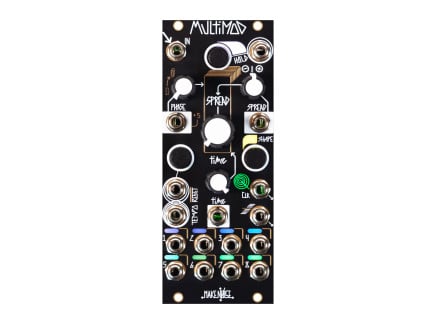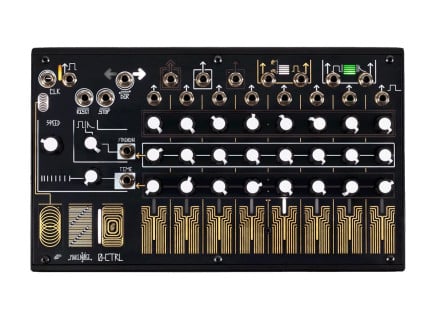Make Noise has just announced their newest module, Jumbler: a signal routing utility for Eurorack modular synthesizers. Jumbler can be seen as a close companion for their recent release MultiMod; however, it's a tremendously useful tool that could provide many valuable functions to any Eurorack system.
In short, Jumbler is a signal router, capable of routing a combination of each of its six inputs to its six outputs. You can think of it like a complex interpolating switch...or as a combination mixer/panner...or as a streamlined 6x6 signal routing matrix. It can be used to route control voltages or audio signals, and we suspect that it will prove that dynamic signal routing can be a fun and rewarding way of interacting with your modular synthesizer.
So let's take a closer look at some of Jumbler's concepts—first pondering the idea of performative signal routing in modular synthesizers as a whole.
Let's Ponder a Matrix, Shall We?
Jumbler is described by Make Noise as a six-channel analog signal combiner and distributor—a way of reconfiguring your system's patch routing dynamically. You can think of it as being conceptually similar to a signal routing matrix, insofar as that it has several inputs, which can be routed to its several outputs. That said, its parameterization is quite different from typical matrix-based signal routers.
Many existing patch matrix modules have a certain number of inputs and a certain number of outputs arranged in a two-dimensional grid, with some means of establishing signal connections at each "node" or "intersection." This is the case, for instance, with both the splendid Instruo lìon and 4MS VCA Matrix. Each of these uses a different physical method of interaction: insertion of specialized cables in the case of the Instruo, and the use of per-node push switches and pots in the case of the 4MS. However, they share a conceptual commonality, in that every potential input-to-output mapping is controlled in an isolated, discrete fashion.
Needless to say, this type of signal routing tool can be tremendously useful. It can be a way of centralizing audio or control routings for your patches, giving you a single point of interaction for managing performative rerouting of signals. These types of tools can make patch routing playable, allowing you to restructure the nature of your instrument on-the-fly. This type of signal routing matrix can even be used as a simple form of "patch memory," as seen in devices such as Donald Buchla's preset-capable 210e Control and Signal Router, or more recent devices like the Erica Synths Matrix Mixer.
However, tools like this bring along with them a number of practical issues. That's right: practicality strikes again. As it turns out, the complexity, size, and cost of a two-dimensional matrix interface increases with every input and output that you add. And while we might like to have continuous control of the signal level/intensity at every possible input:output node, the user interface can become overwhelming and prohibitively expensive quite quickly. We might like, for instance, to have a big, 16x16 matrix with a knob and CV input for control the level of each individual node. But, are you ever really going to use a large number of nodes dynamically at the same time? And in particularly complex patches, the visual state of such a system can be difficult to decipher: it's actually quite difficult to, at a glance, understand the state of 256 rotary knobs arranged in a grid. Who knew??
As such, the user interfaces for such devices commonly utilize LED matrices and an encoder-based navigation method, allowing for etch-a-sketch style navigation of the matrix; this is the approach taken in the aforementioned Erica and Buchla signal routers. This is a great compromise in terms of visual comprehension (and compactness), however, it lacks something in terms of immediacy. While both devices do offer preset memory—and as such, can change signal routing instantaneously—it can be somewhat laborious to define new routings. They're great tools: but tools meant for specific jobs/specific approaches. As such, these interfaces' playability is restricted to methods that allow for preset selection (or in the case of the Erica matrix, randomization). The 4MS VCA Matrix mentioned above allows for more playable access to arbitrary node control, even allowing for continuous control of each of its nodes' signal levels. However, this only really works because it's a relatively small (4x4) matrix. It's an uncommonly thoughtful execution of this general concept, however it does still have 16 potential points of interaction.
Of course, there are other approaches to dynamic signal re-routing. One of the most common in modular synthesizers are switches: devices which can route one input to one of several destinations, or which can select between several sources to pass through to a single destination. Such devices typically behave in a discrete fashion: switching between sources/destinations is instantaneous, and no overlap between inputs/outputs is possible. The less common "switched multiple" is a not-dissimilar take on the one-to-many switch concept, allowing for arbitrary selection of single-source-to-many-destination signal routing (the Doepfer A-182-1 and Intellijel 1U Switched Multiple are interesting takes on this concept, allowing connection of any I/O channel to one of two "busses").
Patch routing is, obviously, a significant part of interacting with a modular synthesizer. The approaches described above have their uses—but they're by no means the only valid concepts for performatively re-routing signals. Speaking for myself, I have an ever-present sort of "ideal" signal router in mind. This device should be able to continuously blend between source/destination routings; and, ideally, a user should be able to interact with it using a very small number of physical controls. This is, of course, a tall order—but an order on which Make Noise's Jumbler delivers. So, let's get into the details.
What Does it Mean to Jumble?
Jumbler is a six-input, six-output signal router with two continuously variable, voltage-controllable parameters. Make Noise considers it part of their New Universal Synthesizer System—a developing set of Eurorack modules first announced with the release of MultiMod earlier this year. Like MultiMod, it provides a streamlined set of controls for "macro"-style addressing of multiple signal paths simultaneously. This suggests to me that multiplicity is a core part of the evolving NUSS concept—and in so many words, I'm here for it.
So, what can you do with Jumbler? Well, you can think of Jumbler as a sort of "interpolating" signal router. Unlike a typical one-to-many or many-to-one switch, it allows for more continuous macro control of signal selection and distribution. As such, you can use it as a mixer, panner, "scanner," and much more. The Radiate and Rotate controls and CV inputs interact with a network of 36 internal VCAs, combining and rerouting the input signals continuously and dynamically. In Make Noise's own words, "One to six inputs are routed to one to six outputs, in an order determined by the Rotate control, and combination determined by the Radiate control."
Imagine, for instance, that you have a signal plugged into only the first input, and you have Radiate set to its minimum value. The Rotate control will allow you to "pan" the input signal to the six outputs. When Rotate is set to 12:00, that single input will be routed to the first output. When moving the Rotate control, the signal will continuously pass through to the other outputs. Already, this demonstrates a huge range of possibilities: you could use Jumbler as a one-to-six panner, as a complex dynamic effect send, or as a control voltage router. If you had patched two inputs in this scenario, changing Rotate would shift them both between the several outputs, maintaining their channel separation. So, imagining that idea from before: you could route two audio sources to several speakers, maintaining equivalent spatial separation between them despite the Rotate setting.
But what about Radiate, then? You can think of this parameter similarly to the way it appeared on the earlier Make Noise RxMx: it allows you to "radiate" your input channel selection outward, blending in signals from adjacent channels as Radiate is increased. So, whatever input is routed to a specific output using Rotate—Radiate will start to introduce sound/CV from the neighboring input channels. It's a way of implementing a simple mixing scheme that eliminates the need for individual level controls at each matrix node: instead, you can blend between several adjacent input channels at any given output channel.
So, Jumbler is a way of continuously selecting a combination of adjacent input channels and routing them to any desired output channel. It performs this operation for all output channels simultaneously, ultimately resulting in a unique set of input combinations at each output at any given point in time. Of course, you don't necessarily need to use all input channels or output channels simultaneously—but the general scheme allows for a huge number of potential use cases.
For instance, let's say you want to continuously crossfade between six distinct sound sources (outputs from an oscillator, or completely independent voices): just patch them into the inputs, choose an output, and use the Rotate/Radiate controls to vary the selection/mix of sources. You could even leave some strategic inputs unpatched, allowing you to pass silence to the output(s) in question—making it possible to use Jumbler like a peculiar macro VCA. Or, if you want to choose between several different CV sources for a single destination: no problem! Just patch your control sources to the inputs, patch an output to the destination in question, and dial in Radiate and Rotate to taste.
The macro-level implications of the Radiate and Rotate parameters encourage more experimental uses for the tool as a whole. What if you patched six outputs from a DPO complex oscillator to six of its own inputs, and then use a sequencer to modulate the Rotate and Radiate controls? What if you used it to route several distinct trigger sources to six different drum modules? What if you and five good friends sent your preferred CV controllers' outputs to the six inputs, and then plugged the six outputs to various parts of a particularly fun, dynamic, and/or skronky patch? I dare say that you'd have one heck of a party on your hands.
As with all of the other styles of 2D signal routing matrix I discussed above, Jumbler isn't a solution to every signal routing scenario. However, its interface provides an unusual and quite interesting way of addressing many of the problems I mentioned before. It minimizes the number of potential points of interaction and maximizes their effect on the entire routing system as a whole. It offers clear visual feedback. It makes very sensible compromises in favor of promoting exploratory use—offering one of the most intuitive and streamlined approaches to continuously addressing a large (6x6) matrix that I've personally seen. It's a great idea, and I'm very eager to see how people will elect to use it!












